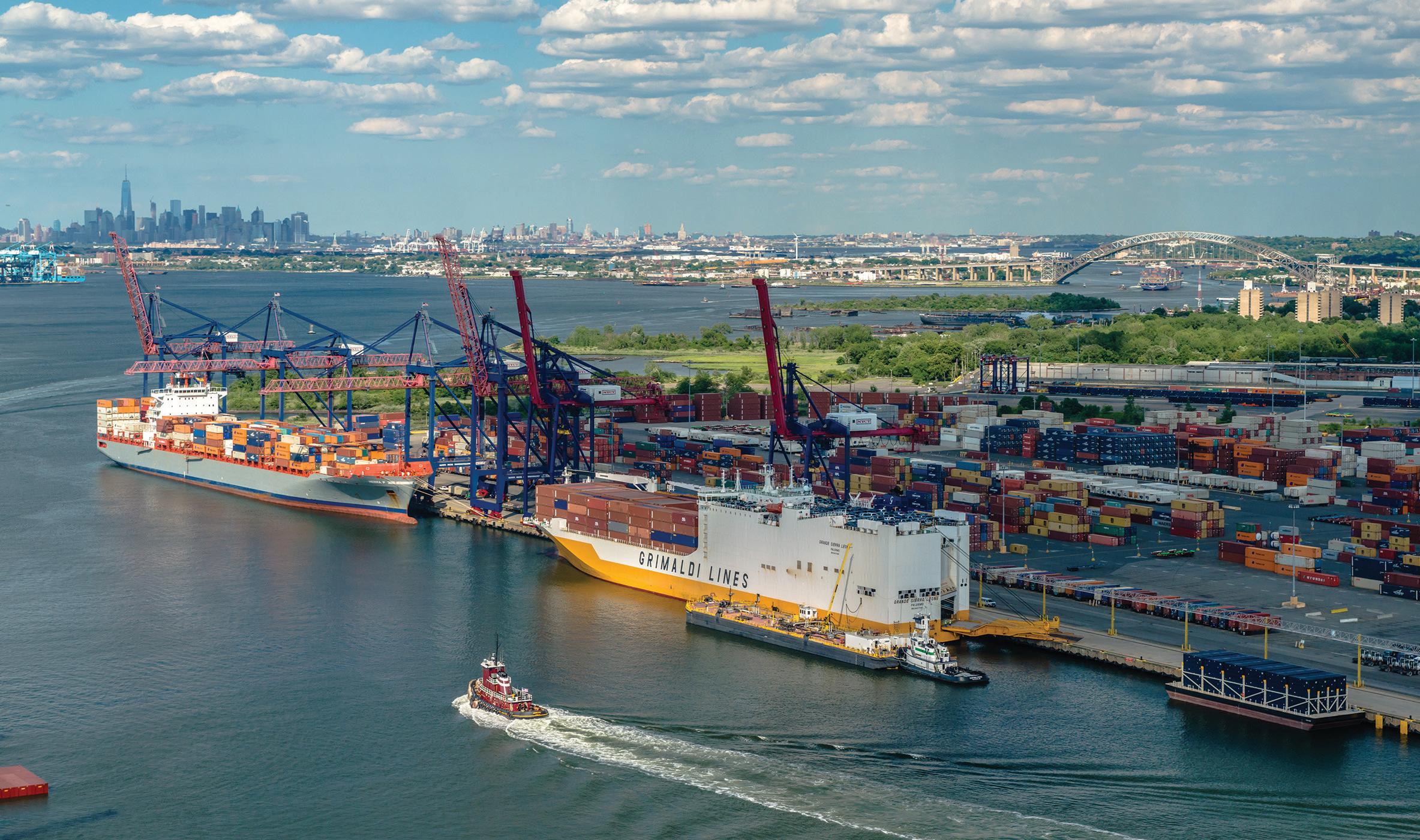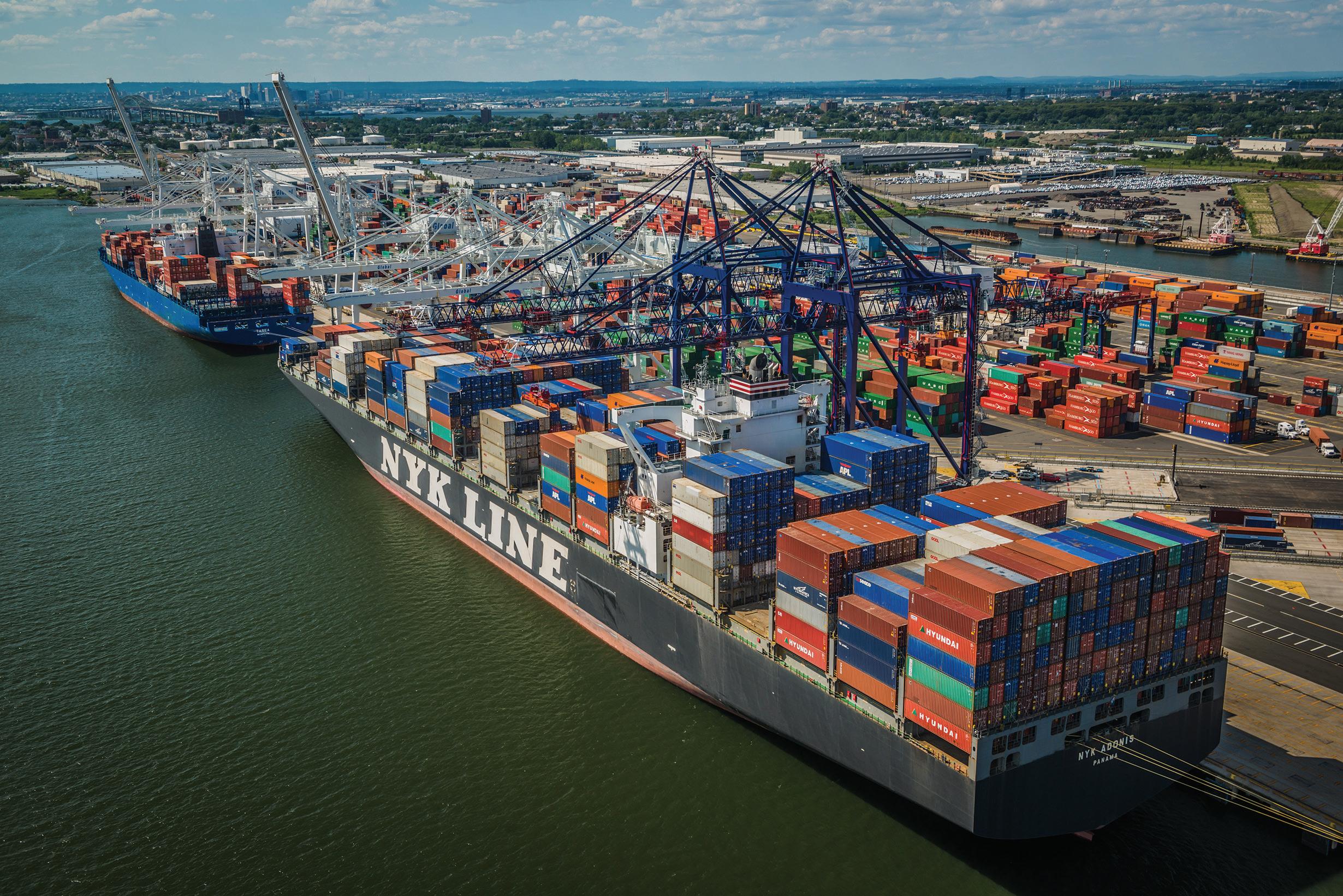
8 minute read
GCT Global Container Terminals Inc
GCT Global Container Terminals Inc. (GCT) is the latest terminal operator to be welcomed as a member of the Association of Pacific Ports. With four terminals — GCT Vanterm and GCT Deltaport in British Columbia, Canada; GCT Bayonne in New Jersey, and GCT New York on Staten Island — GCT’s presence on both the East and West Coasts of North America serves the top container carriers in the world, abiding by the values of ‘safety, pride and professionalism.’ “These are more than just words for us,” Marko Dekovic, Vice President, Public Affairs told the APP as we welcomed them to the Association. “They drive every action, innovation, and success at GCT and are the principles upheld by our leadership, staff, and workforce to provide best-in-class service to our customers and stakeholders.” Indeed, a quick review of their history, current activities and future goals bears this out.
Background
Headquartered in Vancouver, Canada, GCT Global Container Terminals Inc. can trace its history back to 1907 in the Port of Vancouver and 1972 in the Port of New York and New Jersey. The company has three major institutional investor-shareholders with majority ownership in Canada — the Ontario Teachers Pension Plan, British Columbia Investment Management Corporation, and IFM Investors based in Australia.
GCT Canada is one of Canada’s largest maritime employers and has played a key role in developing Canada’s Pacific Gateway. GCT Deltaport, Canada’s largest container terminal in Canada’s largest port, is an 85-hectare (210-acre), state-of-the-art terminal supported by an 1,100-metre (3,609foot) contiguous berth, 12 ship-to-shore cranes, capable of welcoming the largest transpacific container vessels calling on the tradelane. GCT Deltaport boasts a seamless ship-to-rail transfer with 8,334 metres (27,350 feet) of on-dock rail.
GCT Vanterm is a 31-hectare (76acre) container terminal with 619 metres (2,030 feet) of berth, 7 shipto-shore cranes, (with two new cranes added into service in 2021) a modern fleet of container handling equipment, and an on-dock intermodal rail yard with nine tracks totaling 2,962 metres (9,600 feet).
GCT’s East Coast operations were established first with GCT Bayonne in 1972, and then with GCT New York
Photo courtesy of GCT

in 1995. GCT Bayonne, designed to service the largest vessels operating on its tradelane, sits on 67.6 hectares (167 acres) with an 823-metre (2,700-foot) berth and a 15.2-metre (50-foot) draft. It is one of the most technologically advanced facilities in North America, boasting the highest productivity in the New York/New Jersey harbor. The new GCT Bayonne ExpressRail Port Jersey provides fast, seamless connections to inland destinations across North America.
GCT New York operates on 85 hectares (210 acres) with a ship berth length of 918.1 metres (3,012 feet) and six ship-to-shore cranes, 24 paperless, computerized truck gates (and the first on the East Coast to introduce a comprehensive truck appointment system), and a dedicated rail service.
Current trends and activities
“There are a lot of knowns and unknowns with COVID-19 and some dramatic changes in the cargo logistics system,” said Dekovic, “but we’re doing what we’ve historically always done — investing and innovating to ensure we have the capability to handle whatever comes our way.” Like all ports across North America, GCT terminals experienced a significant slow down in the first half of 2020, followed by a strong uptick in the second half, leading to a worldwide logistics imbalance. GCT rose to the challenges that the pandemic brought with it — an increased demand for goods from overseas that resulted in container shortages and congestion — and finished 2020 with a year-over-year increase in throughput despite the difficult first half.
Through it all, GCT has continued to live by mission values (safety, pride, professionalism) that have driven their success over many decades. Looking at just the last few years, GCT has won numerous awards and met significant milestones that highlight their commitment to staff, customers, the community, and the environment.
“Everything we do at GCT revolves around safety and ensuring that anyone interacting with our facilities is kept out of harm’s way,” Dekovic said. “This approach has driven many of our innovations including the recent expansion projects at GCT Deltaport and GCT Bayonne that introduced semiautomated machinery and a redesigned terminal complex.” GCT’s implementation carefully considers the impact on workforce but, noted Dekovic, the safety benefits realized are an important part of the ESG (environmental, social and governance) strategy, even winning an international ICHCA award for innovation in safety for the removing the interaction between machinery and
GCT Deltaport
human beings in the GCT Deltaport intermodal rail yard.
And when it comes to the environmental part of their ESG strategy, GCT has demonstrated a consistent dedication to supporting the Vancouver Fraser Port Authority’s goal of becoming the world’s most sustainable port. Having joined Green Marine in 2014, one of the first terminal operators on the West Coast to do so, GCT has exceeded required certification expectations every year, putting them in the “Excellence and Leadership” level in almost every area and receiving special recognition for their leadership in emission reductions. They also became a Climate Smart-certified company in 2018. Awards for continually demonstrating their commitment to the environment have included Clean50 Top Project and Green Business of the Year awards.
Not to be outdone in their pursuit of environmental leadership, GCT has been a proud supporter of community programs that align with their values and drive positive outcomes, including child and youth support, education, and development; health and safety; community economic development; and environment and sustainability.
Continued growth on the horizon
Over the last decade, GCT has incrementally increased capacity at all of its terminals and Dekovic expects that to continue. Whether that increase has come in the form of deepening the draft at its berth to accommodate larger ships, as was done at GCT New York, introducing modern equipment, and introducing a comprehensive truck appointment system to improve cargohandling speed as was done at GCT Bayonne, continued implementation of innovative systems and technology have allowed GCT to increase throughput without expanding beyond existing footprints. And while capacity has increased with each new project, emissions have been reduced and impacts on the surrounding environment mitigated.
GCT’s two Canadian terminals have also undergone significant modernization projects. In 2019, GCT invested $160 million to densify and modernize GCT Vanterm. Through increasing container handling capacity by approximately 25 per cent within its existing footprint, they not only significantly reduced greenhouse gas emissions but also created about 1,200 new direct and indirect jobs. As part of the modernization project, two modern 14,000 TEU capable ship-to-shore cranes — the most advanced in North America — were delivered in 2020. The cranes are electrically powered, feature regenerative drives that can provide power back into the grid and high-efficiency LED lighting. They also reduce glare and light pollution along with features intended to reduce operational

noise and have been painted a cloudwhite colour to mitigate daytime skyline visibility. The cranes, along with other equipment upgrades and process improvements, will improve safety for the workforce, increase terminal capability, and reduce equipment emissions by 55 per cent —all within the same footprint.
In 2020, GCT Canada announced the completion of the final two tracks of the GCT Deltaport Intermodal Rail Yard Expansion Project, making the terminal the most efficient and capable ship-to-rail discharge facility in the world. The Project is the second, $300-million privately funded stage of the multi-phased Deltaport Terminal Road and Rail Improvement Project (DTRRIP), a collaboration with the Vancouver Fraser Port Authority and the Province of British Columbia. The densification approach to this project demonstrates GCT’s commitment to increasing capacity within its existing footprint and minimizing operational and environmental impacts on the surrounding community.
GCT Canada has also been advancing its way through the regulatory process for the GCT Deltaport Fourth Berth Expansion (DP4) project, a sustainable, phased, and privately-funded incremental expansion of the existing footprint to add a fourth berth, delivering capacity when needed while minimizing impacts on neighbours, environment, Indigenous fishing grounds, and the workforce. The project would increase capacity at the terminal by two million TEU per annum.
Following extensive public and stakeholder engagement that began in 2019, GCT, filed the required regulatory documents in 2020 to the Impact Assessment Agency of Canada and the BC Environmental Assessment Office. Following this, GCT engaged in additional public and indigenous consultation. With the results of the consultation provided by the regulators, GCT is now in the process of submitting the next set of required documents to the regulators. The process, including an environmental assessment, permitting, and construction phases, is expected to be ongoing through to 2029 when the first phase of operations are scheduled to start.
Running on a parallel course, GCT Canada and the Vancouver Fraser Port Authority are in the middle of a judicial review over the Port Authority’s alleged bias in refusing to accept the DP4 Project documents in favour of their own proposed Terminal 2 Project at Roberts Bank. The outcome of the review is expected sometime late in 2021/early 2022.
In welcoming GCT to the Association, we look forward to sharing more of their best practices and innovations that highlight their leadership in the many aspects of terminal operations.
PP











